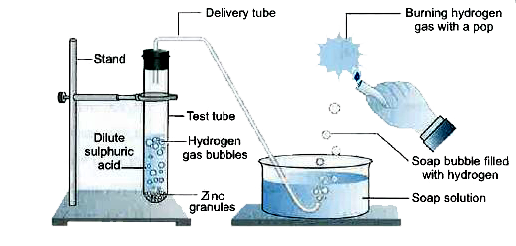In the following schematic diagram for the preparation of hydrogen gas as shown in figure, what would happen if following changes are made ?

In place of zinc granules, same amount of zinc dust is taken in the test tube.
When zinc dust is taken instead of zinc granules to react with sulphuric acid, the hydrogen gas is formed. But the rate of reaction increases in the case of zinc dust compared to the zinc granules, because of increase in surface area the rate of reaction increases. Thus, when zinc dust is used in the place of zinc granules, hydrogen gas is produced at a faster rate.
Topper's Solved these Questions
- ACIDS, BASES AND SALTSBOOK - OSWAL PUBLICATIONCHAPTER - ACIDS, BASES AND SALTSEXERCISE - Board Corner (Single Answer Type Questions)
18 Videos
- ACIDS, BASES AND SALTSBOOK - OSWAL PUBLICATIONCHAPTER - ACIDS, BASES AND SALTSEXERCISE - Board Corner (Long Answer Type Questions)
3 Videos
- ACIDS, BASES AND SALTSBOOK - OSWAL PUBLICATIONCHAPTER - ACIDS, BASES AND SALTSEXERCISE - NCERT Corner (Exercise Questions ) (Short Answer Type Questions)
15 Videos
- CARBON AND ITS COMPOUNDSBOOK - OSWAL PUBLICATIONCHAPTER - CARBON AND ITS COMPOUNDSEXERCISE - CREATING BASED QUESTIONS
23 Videos
Similar Questions
(i) In the following schematic diagram for the preparation of hydrogen gas as shown in figure , what would happen if following changes are made ?
(a) In place of zinc granules , same amount of zinc dust is taken in the test tube .
(b) Instead of dilute sulphuric acid , dilute hydrochloric acid is taken .
(c) Sodium hydroxide is taken in place of dilute sulphuric acid and the tube is heated .
(ii) How do metal carbonates and metal hydrogencarbonates react with acids ?

View SolutionIn the following schematic diagram for the preparation of hydrogen gas as shown in the figure what would happen if the following changes are made?

(a) In place of zinc granules, same amount of zinc dust is taken in the test tube
(b) Instead of dilute sulphuric acid, dilute hydrochloric acid is taken.
(c) In place of zinc, copper turnings are taken
(d) Sodium hydroxide is taken in place of dilute sulphuric acid and the tube is heated.
View Solution
Knowledge Check
Clean small pieces of magnesium, zinc, aluminium, iron and copper by rubbing them with a piece of sand paper. Take them in separate test tubes. Add about 10 mL of dilute hydrochloric acid to each of them.

Consider the following statements.
(i) The rate of evolution of hydrogen gas bubbles is not same in all the test tubes.
(ii) The rate of formation of bubbles is the fastest in the case of magnesium.
(iii) The reactivity decreases in the order:
Mg>Zn>Al>Fe>Cu.
(iv) In the case of copper, no bubbles are seen and the temperature also remains unchanged. This shows that copper does not react with dilute HCl.
Identify the correct option.AOnly (i) and (iv)BOnly (iii) and (iv)COnly (iii)DOnly (i), (ii) and (iv)
In the schematic diagram for the preparation of hydrogen gas as shown in figure, what would happen if following changes are made ?
(a) In place of zinc granules, same amount of zinc dust is taken in the test tube.
(b) Instead of dilute sulphuric acid, dilute hydrochloric acid is taken.
(c) Sodium hydroxide is taken in place of dilute sulphuric acid and the tube is heated.

View SolutionIn the following schematic diagram for the preparation of hydrogen gas as shown in figure, what would happen if following changes are made ?

In place of zinc, copper turnings are taken.
View SolutionIn the following schematic diagram for the preparation of hydrogen gas as shown in figure, what would happen if following changes are made ?

Instead of dilute sulphuric acid, dilute hydrochloric acid is taken.
View SolutionIn the following schematic diagram for the preparation of hydrogen gas as shown in figure, what would happen if following changes are made ?

Sodium hydroxide is taken in place of dilute sulphuric acid and the tube is heated.
View SolutionGive reason for the following:
Zinc granules are preferred for the laboratory preparation of hydrogen rather than pure zinc.
View SolutionLook at the figure shown and answer the following questions :

What change would you observe in the calcium hydroxide solution taken in test tube B?
View SolutionApparatus: Big test tube, small test tube, bent gas delivery tube, rubber cork, thistle funnel, stand, etc.
Chemical : Acetic acid, sodium carbonate power, freshly prepared lime water.
Procedure : Arrange the apparatus as shown in figure. Plance sodium carbonate powder in the big test tube. Pour 10 ml acetic acid through the thistle funnel. Observe the changes taking place in the two test tubes.

What is the colour change in the lime water? Write the related equation.
View Solution
